Hillstream Loaches - The Specialists at Life In The Fast Lane
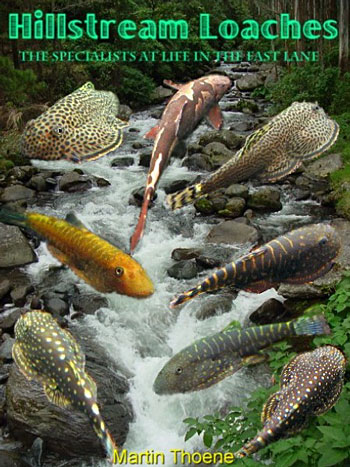
Introduction
Fish seem to be able to adapt to live in just about any environment that they choose. Over millions of years different families have adapted themselves to fill ecological niches that often require quite extreme measures in order to ensure survival of the species within the chosen environment. Sometimes these very adaptations can present the Aquarist with some dilemmas when he/she wants to keep these fish in their aquarium. In this article I have attempted to include as much as possible in order that anyone contemplating the keeping of the Balitoridae family of fish, often called Hillstream Loaches can better understand their requirements and my own solution to keeping them successfully.
What are Hillstream Loaches?
The fish referred to as "Hillstream Loaches" come under the Family Balitoridae. All these fish have varying adaptation of form from what might be termed the "classic" fish shape in order to cope with living in fast water.
Genera
|       |
Why should body shape be important?
Water is an inherently heavy substance to move through. You know how difficult it is to run through chest deep water. Any movement requires energy, and the easier it is for an organism to move through a liquid or the air, the less energy is required for the movement. We humans are hardly what you could call aerodynamic, because we move through the air at relatively slow speed, but look at the effort taken by swimmers to make themselves "slicker", just to increase their speed through the water a little over the speed we can jog at in air.
For a fish that lives in fast flowing water movement isn't a problem. Once in the water flow, no energy is required, apart from minimal steering effort. The problem in a stream is staying still. I believe that the various physical adaptations of these fish are all forced upon them by the need to conserve energy and the degree of adaptation may be governed by the speed of the water that they choose to live in. Why do I think this? Any moving object, whether it moves through a gas or a liquid creates Drag.
What is Drag?
Drag is defined as aerodynamic resistance of the object through the water. Drag is generated by the difference in velocity of the solid object (the fish) and the water. It makes no difference if the fish moves through the water, or the water moves past the fish, drag will still be generated. We tend to think of sharp pointed noses on things like fighter aircraft as being aerodynamic, which indeed they are, but the air (or water) that trails behind the fish in this case is what creates the drag and the smoother it leaves the fish, the less drag will be created. A very low drag coefficient shape is a sphere with a cone on the side that the air departs (i.e., a teardrop shape).
Look at the shape of the beautiful Sewellia lineolata
Of course, a fish is not a two-dimensional object. The side view shows more streamlining

Effectively, the flattish bottom of the fish, plus a rounded head and a tapered off body creates a sort of classic wing shape, and wings create lift. A fish of this shape swimming free in a fast water flow will have a tendency to be lifted by the action of the water flowing past. Indeed, I've witnessed this in my own fish in the infrequent times they decide to swim from a solid surface.
Lift is created by the water flowing over the fish having to travel further than the water that flows under the fish. This creates a lower pressure above and therefore induces lift. The fish can use this as a low energy consumption way of vertical movement, but in reality anything that puts it into the fast moving water flow will require more energy consumption by swimming to maintain a chosen position. It is inherently less energy consuming not to move, but the effect of drag is trying to move the fish, so how have they adapted in order to counter this effect?

Some of the species have fins that are enlarged to a point that allows them to shut out the "under flow" whilst others have pectoral and pelvic fins that overlap and create a larger shut off area. In these fish, the rear portion of the pectorals is
If you compare one species to another, you'll see that the fish with un-joined fins are invariably a slightly more rounded body cross section, whilst the fish with the joined, full sucker type of finnage are more laterally compressed to varying degrees. Could there be a reason for the various degrees of form adaptation?
Another component of drag is known as Form drag. This relates to the shape of an object. The thickness of an aircraft's wing, relative to it's width is known as it's "chord". This effect it's lifting capability. A thick chord (like on a Boeing 747) creates the huge lift to get the monster off the ground, but does generate increased drag, whilst that of a fighter is thinner and creates less lift. This is why fighter aircraft, though lighter in weight require much faster take off speeds, and create less drag. So a fish that has less "chord" will create less lift, and less drag, plus a by product of the increased plan body area is that the effective suction induced by the fin "pumps" will be increased and the fish's potential for staying put in even faster water increases.
Many species have minute spines on the lower edges of their fins which also resist the drag of the passing water.
It is my belief that the highly flattened species may live in regularly faster streams than the less specifically adapted ones. Of course, the evolution of a species is not 
Another drag component in aircraft is Induced Drag. This is created at the wingtips by the meeting of the low and high pressure areas. This creates vortices, which contribute to greater drag by creating turbulence behind the aircraft. This is why large aircraft with their deep chord wings require large separation distances (2 miles, I believe) on airport approaches. Their "wake" disturbs the air that much. The geometry of the wing (it's relationship of length to chord) affects Induced Drag. A long, thin wing creates less, so a thin chorded, wide finned fish would have less inherent Induced Drag on the occasions it decides to detach itself from a surface and move around. All these physiological adaptations create a fish that can stay exactly where it wants to be at little expense of energy to the organism.
So, do the non-sucker type fish live in slower waters?
Possibly. I've noticed some of my species tend to not sit directly in the flow of a powerhead. Maybe they don't naturally live in such fast water, or maybe they choose calmer areas within a stream and don't need such extreme adaptations.
Homaloptera have large pectoral fins that they use as aerofoils to "wing" themselves down onto a rock in the water flow. They utilize the passing water and by angling the fins they create reverse lift and "fly" downwards. Without the sucker adaptations, their ability to maintain station in a really fast flow is reduced.
Has their environment changed these fish in other ways?
 Many of these fish have been exported from their home lands, to all over the World and countless numbers have likely perished when other fish in the same tanks may have been a picture of health. Why should this be?
Many of these fish have been exported from their home lands, to all over the World and countless numbers have likely perished when other fish in the same tanks may have been a picture of health. Why should this be?
Logically, it is likely to be the difference in relative water movement and therefore oxygen content between the "conventional" aquarium and their home streams. Are they getting insufficient oxygen? Surely, we could just increase aeration a bit and they'd "make do"? But how come the other fish are so happy?
The answer may lie in the fact that the oxygen is carried in the blood by the respiratory pigment Hemoglobin. Oxygen can dissolve directly into the blood, but (in Humans for example) the oxygen carrying capacity of blood containing red cells full of hemoglobin is 70 times that of blood. The special feature about the binding of the oxygen to hemoglobin is, unlike in the oxidation of say, Iron (II) to Iron (III) (rusting), and over a narrow range of conditions, maintained by physiological regulation, the reaction is reversible. The pigment can easily pick up oxygen at the lungs or gills and give it up equally readily at the tissues where it is required for respiration. There is an iron ion (Fe2+) at the center of the central haem part (a type of metalloporphyrin) of the hemoglobin molecule, which is the oxygen binding site. The precisely controlled spatial inter relationship of the molecules in the surrounding globin (a variety of protein) and the resultant molecular forces act to prevent irreversible bindings. The special nature of the arrangement is evidenced by the fact that the haem group isolated from the globin will only bind with the oxygen irreversibly.

With rare exceptions, hemoglobin occurs in all vertebrates and many invertebrate groups. As far as is known, the haem parts are all identical, whereas the globin portions of the molecule vary. Herein lies the beginnings of the answer why these fishes struggle in captivity. Small differences in the structure of the globin portion have a dramatic effect on the physiological properties of haemoglobin. The ease with which a particular variety of hemoglobin takes up oxygen is termed 'the affinity of the haemoglobin for oxygen'. Haemoglobin is also sensitive to the level of dissolved Carbon Dioxide (CO2), and to the temperature. Relatively high CO2 levels reduce the haemoglobin's affinity for oxygen. This is but one way Evolution has exploited the properties of biochemical substances. CO2 is a waste product of of cell respiration, so CO2 levels tend to be higher in those tissues that are doing 'work', and where, therefore Oxygen is needed. The high CO2 level actually 'helps' the hemoglobin unload O2.
 Rising temperatures reduce the affinity of haemoglobin for O2. Fish are the same temperature as their water, so the decrease in affinity can be sufficient to prevent adequate loading of the pigment at the gills, especially as the fish has a low affinity pigment. This is compounded by the fish's increased demand for O2 at the higher temperatures, and by the reduced solubility of O2 as the temperature rises. Equally, falling temperature increases the haemoglobin affinity, but decreases the ease of unloading at the tissues. In other words, you can't juggle a particular species haemoglobin affinity, by altering the temperature of it's environment.
Rising temperatures reduce the affinity of haemoglobin for O2. Fish are the same temperature as their water, so the decrease in affinity can be sufficient to prevent adequate loading of the pigment at the gills, especially as the fish has a low affinity pigment. This is compounded by the fish's increased demand for O2 at the higher temperatures, and by the reduced solubility of O2 as the temperature rises. Equally, falling temperature increases the haemoglobin affinity, but decreases the ease of unloading at the tissues. In other words, you can't juggle a particular species haemoglobin affinity, by altering the temperature of it's environment.
Some hemaglobins have a greater affinity for O2, and bind easier, the benefits of which are obvious. But the downside of high affinity is that it 'costs' the organism more in terms of engineering the physical circumstances conducive to unloading the O2 at the tissues. If the O2 binds easily it is harder to "unbind". With high haemoglobin affinity, a fish can inhabit low O2 level environments. Carp for example, have high affinity haemoglobin,so can inhabit still waters.
Some fishes, by contrast have adapted to waters where the O2 levels are far higher, such as fast flowing streams and the upper levels of the open sea. Here there is no need for a high affinity pigment, and such fish have evolved a low affinity pigment, that has little difficulty in binding with O2 because of it's abundance. The benefits of a low affinity pigment are in the ease with which it unloads it's O2 at the tissues, saving the of biochemically "engineering" the unloading process which other fish have to pay.
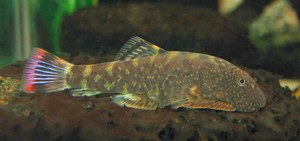
These fish are therefore just not found in low oxygen content waters, and the average home fish tank falls somewhere into this category.
It is therefore logical to suppose that these fish have the physiological adaptation of low affinity haemoglobin and are therefore not able to survive in a tank unless it has adequate levels of dissolved O2.
Referring back to the various families above, and my theories about the relationship of body shape to likely water speed in their chosen environment, I think it likely that a cylindrical cross sectioned fish such as a Nemacheilus sp., may come from slower streams, and therefore possibly be more tolerant than a highly physically adapted fish like a Beaufortia.
So, if I want to keep these fish, what do they need to survive in my aquarium?
In theory, increased aeration in a tank will help these fish, but that's not the whole story. Because of their highly specialized adaptations, you'll never really get to see them living as they would in the wild. They'll tend to congregate around the airstone flow, or a power-head outlet, and not want to move out of the high O2 content water. Much better to work out a way of giving them a more natural, flowing tank. You'll end up with more natural behavior and it's possible that they'll be so happy, they may even feel inclined to breed, which is ultimately a good goal to strive for.
I decided to design a new concept of tank specifically for these type of fish, and came up with what I christened "The River Tank". Ideally, this concept is best utilized in a long tank, preferably at least 3 feet long.
Most Power-heads and Power Filters used in regular tanks impart a tumbling action to the water, but don't give a uni-directional flow which is what these fish primarily encounter in the wild. I devised a system utilizing a tubular "manifold" similar to an under-gravel filter, but with non-perforated tubes to transport water from one end of the tank via intake sponge filters, to be blasted back down the tank by over sized Power-heads.
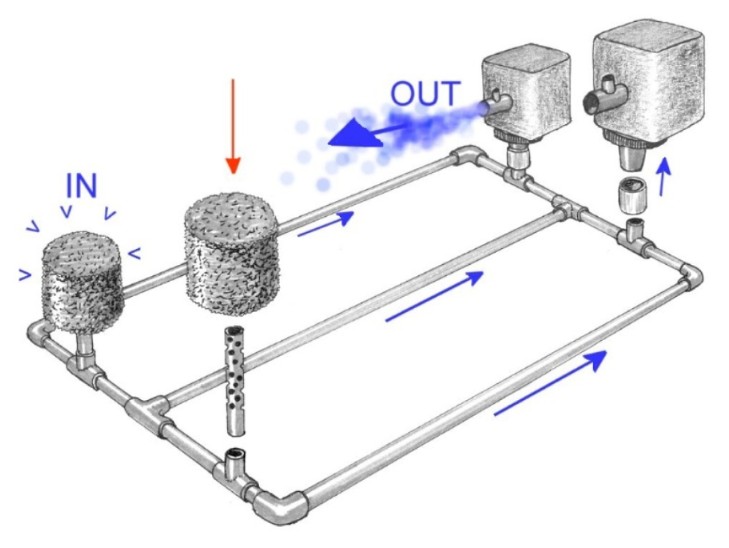
The tubing used is three quarter inch diameter domestic overflow piping glued together with "Osmaweld" glue. Similar glue for PVC pipe is available in most hardware stores. My second tank was set up without the central tube shown in the
Details on constructing a River-Tank manifold can be found here.
drawing and I found that it is far harder to secure it adequately under the gravel. The central tubes allow décor to hold it down. The Osmaweld glue effectively welds the components together, so accurate pre fitting and checking is advised before finally gluing. I put reference marks on the pieces to ensure correct alignment, you get 30 seconds of adjustment time, so mistakes cost dear if you don't check. At the Powerhead end, a piece of 1" bore flexible hose was cut as an adapter to take the conical uplift adapter that Aquaclear Powerheads come with. I used 2 Aquaclear 802's.
Tank Decor

Their beds consist of sand, gravel and various sized stones and rocks, which provide good hiding places out of the relentless current. Here, where the rainforests rise up the mountains, bamboos and wild bananas shade the banks. In places, there are tree ferns and giant trees upon which orchids grow.
These streams are highly oxygenated and out of the shade, well illuminated. There are no floating plants and the fish are lively, active creatures. The environment is an attractive one, due to it's very lightness, cleanliness and liveliness.
Virtually everywhere, the untiring water will have loosened small pieces of rock. These fall into the stream bed of smooth pebbles and gravel. Sand only remains in very sheltered areas. Therefore in a tank, we should endeavor to create this sort of environment.
I cover the power-head manifold with fine gravel or sand. How you design the décor is up to you, but the fish need large areas of rock for algae to grow on as they will naturally graze on it and the micro organisms it contains.
Use smooth, non calciferous rocks of various sizes. These provide shelter from the water flow. The sucker-type fish like to cling to the rocks and the aquarium glass sides. Some species will venture onto the gravel to search for food, but others almost exclusively will stay on surfaces they can cling to. It seems they are uncomfortable about not being able to suck down upon a surface.
To promote algal growth, you should ensure bright lighting. I use 4 40W tubes. This also allows higher plants to be grown, with benefits in water quality.
Here is a picture of my tank in 2004:

My 65 gallon tank, set up in September 2001 has 3 intake sponges, each 4" tall by 4" diameter. These provide pretty good biological filtration with water being sucked by
the Aquaclear 802s. In addition, the tank has an Aquaclear 300 and 150 hanging on  the back, with an Eheim 2213 and Fluval 203 cannisters. The Eheim occasionally has carbon in it, but not all the time. This sounds like a lot of water movement until you consider the streams these fish live in may have water speeds in the region of a meter per second.
the back, with an Eheim 2213 and Fluval 203 cannisters. The Eheim occasionally has carbon in it, but not all the time. This sounds like a lot of water movement until you consider the streams these fish live in may have water speeds in the region of a meter per second.
A natural stream in South Kalimantan, Indonesia.
Temperature is best kept from 65- 78F, avoid higher if possible. As discussed above, Oxygen will not dissolve so well at higher temperatures, so keeping them lower is best for maximum O2 content. Because of the diverse sources these species come from there must, I'm sure be a large range in the natural temperatures that each experiences, but generally lower than normal temps for a "Tropical" tank are best. All of my tanks are only heated by heat-sink from the Powerheads and Power Filter, even in the depths of Winter. Certainly in many countries, some species are sold as "Coldwater" fish, i.e, unheated.
During warmer weather, overheating can be a problem. I have found that a small household fan, set to blow air across the water's surface has a marked cooling effect. It does however increase evapouration significantly.
With regard to water parameters, they aren't too fussy, but avoid extremes. Neutral to slightly acid Ph is good and mid to low hardness seem to suit them fine.
I want to set up a specialized tank for them, but what do they eat?
For the Sucker-belly species firstly, you need a good algae growth on your rock work. They will take prepared foods, but ultimately, it seems that algae and all the little goodies it contains are a large contributor to long term success with these fish. In their natural habitat, they graze the rocks for micro organisms (aufwuchs).
Therefore, they are not suited to fresh, newly set up tanks. They will take pellet food, flake, Algae wafers, shrimp pellets, live and frozen foods, particularly frozen Bloodworm and Brine Shrimp. Jim Powers feeds his fish blanched kale leaves, which they relish.
Several of us that have been keeping them for a while have set up a small aquarium
Here, 3 different species enjoy the treat of fresh algae.
Because of their normal, low food value diet, they tend to be very active, and feed a lot of the time. When buying Gastromyzon and similar species, look for active food searching. If they're not moving around, be suspicious that all is not well. The only time I've ever bought inactive ones, they died without any obvious reasons. There are two reasons for inactivity. Firstly, low oxygen levels in dealer’s tanks can contribute to long term damage because of oxygen deficiency. Secondly, the reason for lack of food searching may be due to ill health.
Most of the other fish that are less specialized will eat similar foodstuffs, but Nemacheilus types seldom eat Algae. It is not a major part of their diet. They have far more conventional Loach type barbels for searching out tid-bits in the gravel and other décor. Mine will also take food from the water surface.
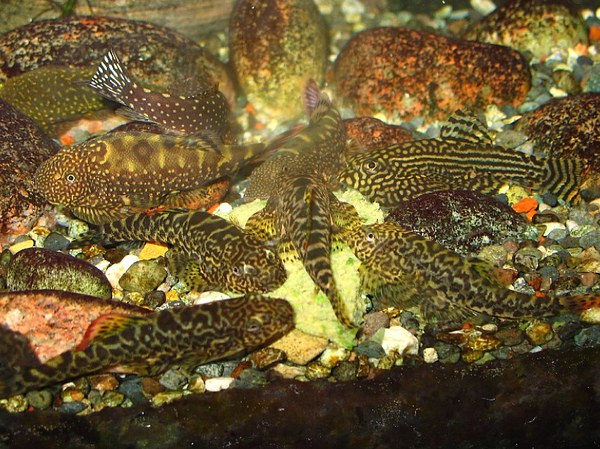 |
| A River-Tank of mixed species all avidly feeding on home-made frozen food mixture. |
Can I breed them?
When this article was first written, the answer was possibly. At that time few people had bred any species of Hillstream Loach. Thanks to my tank design, a whole lot more people have bred them, plus the design has been used successfully by others to breed various types of non-loach rheophilc fish species.
 One of the easiest species to breed is Pseudogastromyzon cheni. They produce
One of the easiest species to breed is Pseudogastromyzon cheni. They produce
smallish broods of babies and once they start breeding, they will spawn every couple
of weeks. The male digs a spawning pit, usually doing so by sliding backwards off of a pebble and digging out under it with rapid flicks of his tail. (See above).
Details of P. cheni breeding here.
Other species that have bred are Liniparhomaloptera disparis by Jim Powers and myself, plus Sewellia lineolata, first bred by Emma Turner .
So if I get my tank set up like this, what do I look for when buying fish?
As with all fish look for signs of disease or anything unusual. Be particularly aware of any fish that exhibit any patchiness in their color. This may be indicative of a disease that seems to be their greatest downfall. Any fish that get patchy and go off their food may die fairly quickly. Jim Powers had some success using Maracyn-Two (minocycline) and Maracyn (erythromycine concurrently.
Details can be found here.
If you want to know what fish a dealer has this can be difficult because these fish get called all sorts of fancy names by the trade, usually at the export end, and these names, many completely misleading have stuck.
Look for:
- Chinese Butterfly Plecos
- Borneo Suckers
- Lizardfish
- Flossensaugers (in Germany)
- Hillstream Loaches
- Butterfly Loaches
- etc, etc. (The Ornamental fish trade is very imaginative)
They are not "Plecos" for starters! Plecostomus are South American Sucker-mouthed Catfish. These fish are all Old World species. Lizardfish is often applied to some of the Homaloptera species just to confuse more!
Unfortunately, most aquatic shops aren't knowledgeable enough to accurately ID the fish species, which is hardly suprising because quite often batches of fish are mixed species and some may be un-described species.
Exact species you buy is often a case of what is in the shop. Many different species come in under "catch all" type names, and reference to the Loaches Online Species Index may help provide definitive ID. This whole group of fish has had some serious taxanomic sorting out in 2006 thanks to the excellent work of Dr. Tan Heok Hui at The Raffles Museum of Biodiversity in Singapore, who has described several new species and connected definitive photographic ID's with preserved specimens. Often, the scientifically examined, preserved fish bear little resemblance to life colour and markings, which makes ID for the average person very difficult.
Are they territorial? Do they fight with other fish?
Given the specialized conditions necessary for their well being these are a fascinating group of fish and I find them very entertaining. Their aggression seems to be limited to body charges and swipes mainly. They don't have the equipment to do any serious damage. The Suckerbellys will have little battles consisting of Dorsal fin flashing at one another and basically, they try to push one another away from the chosen spot.
I've found that Homaloptera like to have a sort of "home" rock or position in the tank and will always return there. They will defend it from others of their species or similar, yet ignore other totally different species. Nemacheilines will get into more pushy, side by side action, taking poses and trying to look "big" to one another, but these occurrences are far rarer than the daily Gastromyzon type disputes.
Sewellia species seem to engage far more in the habit of "topping" when fighting. They try to get on top of each other. Other wide-bodied species such as Beaufortia will do this also.
How big do they get?
Most of these fish are in the 1.5" to 4" area, and as such make good aquarium inhabitants because they are not going to get too big. I find myself becoming more and more fascinated by these fish and their special nature. As more and more interest and understanding develops for them, hopefully more and more aquarists can keep them successfully. Now that people like Jim Powers, Emma Turner and myself have proved that it is possible to provide aquarium conditions that will induce these fish to breed in captivity the possibility of aquarium acclimatized F1 and further generations may reduce the need to catch them in the wild. Their slow growth rate may prevent the possibility of serious commercial breeding however.
The aquatic trade has for far too long just sold these fish as yet another commodity and I think they should be more responsible in telling their customers the specialist nature of these fish and also educating themselves as to their proper care.
I fear that all too many of the fish imported so far have perished due to literally suffocating to death. They need specialist set ups for maximum life potential and I think we should give them that or not keep them.
Martin Thoene
With grateful thanks to Jim Powers and Dr Gabriella Kadar for editorial comment and additional text.
References:
- Suckerbelly Loaches, by Don Kuhns
- What is Drag?…..NASA, Glenn Research Center.
- An article by Peter Brokenshire in the March 1993 edition of Aquarium magazine on Fastwater Fishes Oxygen specialization.
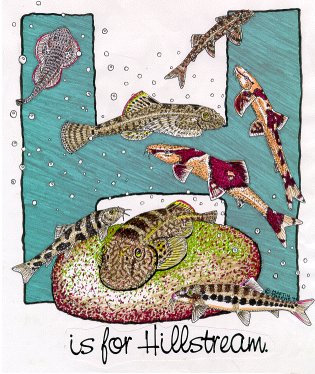
Document Actions


